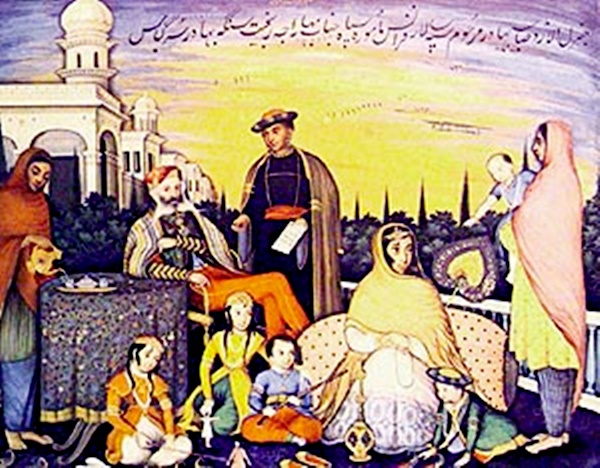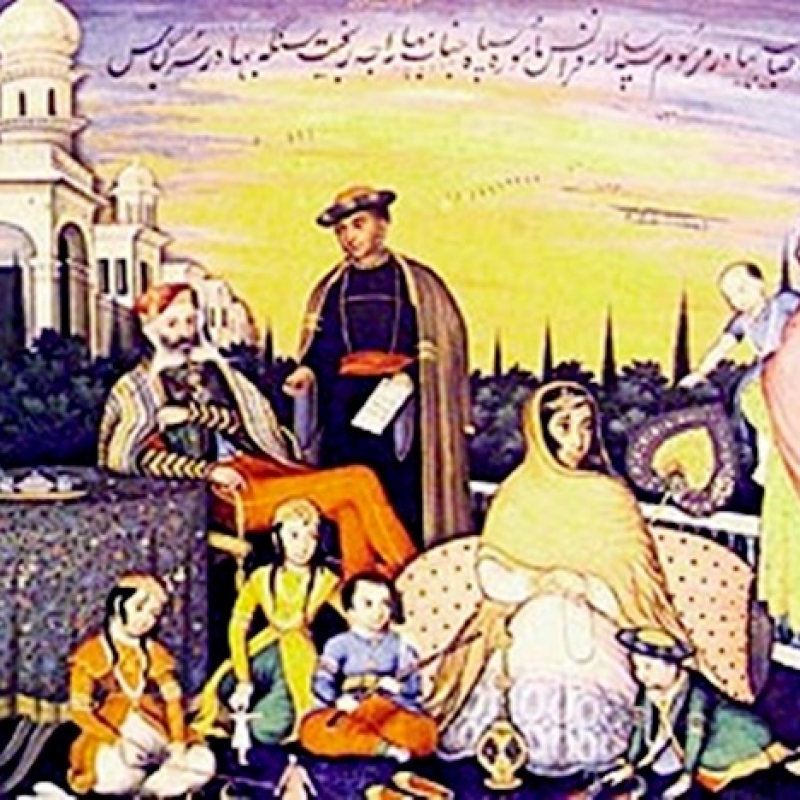The paintings of foreigners during the colonial rule give an interesting insight into how they interacted with those from ‘the mysterious East’. Here, Prof B.N. Goswamy writes about paintings that emerged from the time, specifically from the court of Maharaja Ranjit Singh. (Photo courtesy: The Tribune)
This article appeared originally in The Tribune, Chandigarh and is reproduced here with permission.
One does not often realise it, for only a few names are mentioned again and again, but the glittering court of Maharaja Ranjit Singh at Lahore teemed with people of foreign origin: Not only those who came visiting—of these there are long lists, again—but those who were in his service. As many as 54 of them are mentioned, drawn from all over the world, mostly adventurers who came in search of employment to the mysterious East: from Italy, Greece, Spain, Germany, even England, but most of them from France. An odd medical doctor or two apart, nearly all of them the Maharaja engaged to train his army, which eventually turned, with their efforts, into the greatest, most disciplined, fighting force perhaps that the British had ever to face in India.
Also read | Art N Soul: Jodhpur’s Polish Designer
Among the most gifted, and engaging, of these men who served a foreign master, far away from their homes, were three Frenchmen—Ventura, Allard and Court—and I was reminded again of their presence in these parts while working on related material recently. All three of them had once served in the French army, and all three travelled, the first two together, towards the east, after Napoleon’s fall. It is not as if they headed straight for the Maharaja’s domains: they spent years on the way, taking up short assignments in Iran, or Afghanistan. But the early twenties found them here in the Punjab, working closely with Ranjit Singh, the first one on the infantry, the second on cavalry, and the third on his artillery. That story, however, has been told well, and at length, by many. What interests me about these men is the extraordinary manner in which they struck root here, leading their lives in the manner that Indian noblemen and men of rank did, running establishments with a regiment of servants of all description, two of them settling down with Indian wives: young, attractive women from Kashmir. Memories of France did not ever completely leave them: General Allard always wore on his person, proudly, the Legion of Honour he had been honoured with in France, and visitors to his home remarked on the fact that the eagle and Napoleon’s flag were displayed on each wall of his. But, in so many other respects, their ways and their styles were of a native.

There are some vivid descriptions by visiting Europeans of the art that these Frenchmen surrounded themselves with. "General Vesntura’s house", the Austrian traveller, Hugel, noted, "built by himself and though of no great size, combines the splendour of the East with the comforts of a European residence. On the walls of the entrance hall, before the range of pillars on the first storey, was portrayed the reception of the two French officers at the court of Ranjit Singh, consisting of many thousand figures. The second room is adorned with a profusion of small mirrors in gilt frames..." Ventura’s house was situated in "Anarcolly", so was Allard’s, almost next-door. In Allard’s, the Englishman Barr also saw much, among them a portrait of the General "which bespeaks him to have been a handsome and benevolent man, possessing much firmness and decision of character, tempered with mildness." What intrigued Barr greatly, however, was "what in truth may be called the ‘Painted Chamber’, as it is adorned with pictures of the battles in which the two generals were engaged, and executed on the chunam walls by native artists." To Barr’s Victorian eyes, so used to academic work, the perspective of these battle-scenes looked most curious, even ridiculous, but he did remark on "the policy of these gallant soldiers", which has led them this far to assimilate their dwellings with those of the native population,..."
Also read | Art N Soul: Different Snakes, Different Ladders
That these men grew to be fond of ‘native artists’ one knows from other sources. General Court is known to have commissioned a Lahore artist to execute paintings for the account of his stay in the Punjab that he was writing. But—even more interesting—one knows now that, at the asking of a colleague in France, Allard had the Lahore painter, Imam Bakhsh, illustrate a copy of that great French classic, the Fables of La Fontaine, some most engagingly painted leaves of which were shown recently at the V & A in London. For me, personally, a favourite remains that wonderful portrait of Allard and his family, which was painted in 1838, the last year of the General’s life. In this, the General sits on a chair, thoughtful expression on the face, his long, forked beard prominently on view, almost ignoring a letter in Persian that a ‘munshi’ holds in his hand for him to sign with the pen he offers him. The General’s Kashmiri wife sits on the floor close by, resting, Indian-fashion, against a large bolster even as their five children play about, or are held by ayahs, playing with dolls and toy-guns, great charm writ on their lovely faces. It is a moving picture in many ways, ‘official’ but also informal, full of innocence and human warmth. The inscription in Persian at the top of the painting, evidently added after the General’s death, gives it a touch of poignancy, for it speaks of this being a portrait of "the late General Allard Sahib Bahadur, Commander of the forces of Maharaja Ranjit Singh Bahadur, now residing in heaven".
A Different Battle
Speaking of the paintings that he saw everywhere in the Punjab, Lt. Barr drew attention, with his usual sense of fun, to some on the walls of the large Nalwa haveli at Gujranwala. "Some of these related to their gods", he noted, "others to the harem, and the latter, as may be supposed, were by no means most decorous in their description. As several of them have been entirely removed, and many glasses of others are cracked, we asked our guide for an explanation; and he replied that the apartment belonged exclusively to the fair daughters of Eve, who on one occasion had quarrelled among themselves, and to settle their differences had resorted to the feminine weapon of slippers, which they heroically flung at each other’s heads, and thus caused the destruction apparent in the late Sirdar’s property"(!)
This article has been republished as part of an ongoing series Art N Soul from The Tribune.













